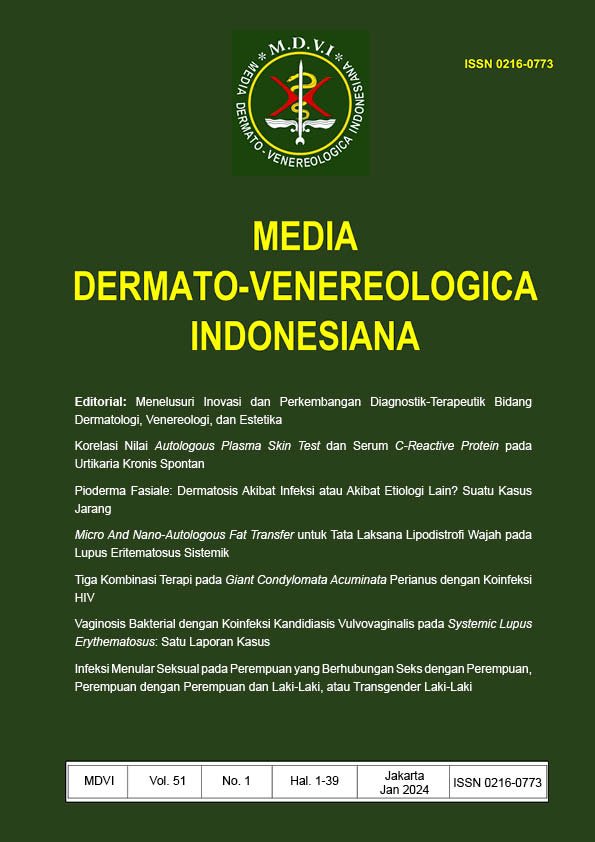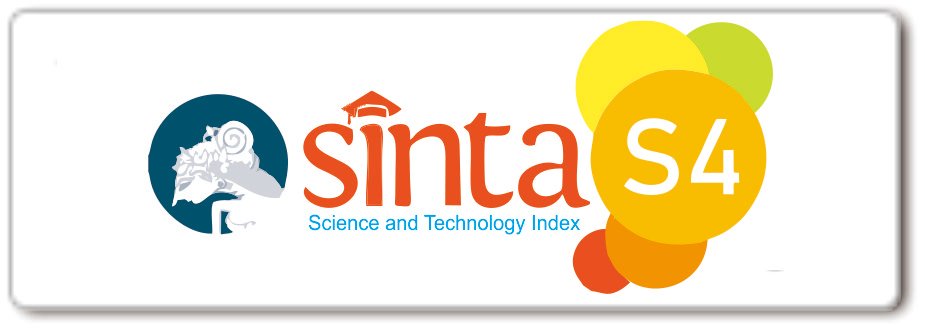TIGA KOMBINASI TERAPI PADA PERIANAL GIANT CONDYLOMA ACUMINATA DENGAN KOINFEKSI HIV
DOI:
https://doi.org/10.33820/mdvi.v51i1.306Keywords:
elektrokauter, giant condylomata acuminata, HIV, simetidin, trichloroacetic acidAbstract
Giant condyloma acuminata (GCA) atau tumor Buschke- Löwenstein, merupakan varian kutil anogenital yang jarang dan unik. Kondisi imunokompromais terutama infeksi Human Immunodeficiency Virus (HIV) berkaitan dengan perkembangan GCA. Sampai saat ini belum ada pedoman baku emas dalam penatalaksanaan GCA dan masih menjadi tantangan bagi dokter spesialis dermatologi dan venereologi, karena ukuran lesi yang besar, kemungkinan invasi dan transformasi maligna, serta tingginya risiko rekurensi. Dilaporkan sebuah kasus GCA perianal pada pasien laki-laki berusia 20 tahun dengan koinfeksi HIV. Gejala klinis berupa vegetasi bertangkai sewarna kulit, permukaan verukosa, berbentuk cauliflower, multipel, berukuran 5 x 2 x 2,5 cm di regio perianal sampai menutup regio anal dengan beberapa papul verukosa kecil di sekitarnya. Diagnosis ditegakkan berdasarkan pemeriksaan fisik, tes acetowhite positif dan pemeriksaan histopatologis. Pasien diberikan terapi kombinasi menggunakan elektrokauter dan Trichloroacetic Acid (TCA) 90% setiap minggu serta cimetidine per oral dengan dosis 3 x 500 mg setiap hari selama 3 bulan. Resolusi pada seluruh lesi GCA setelah 5 minggu terapi dan tidak didapatkan rekurensi pada follow up bulan ke-5. Tiga kombinasi terapi: elektrokauter, TCA dan cimetidine dapat dipertimbangkan sebagai penatalaksanaan GCA dengan koinfeksi HIV karena teknik invasif minimal dan cimetidine sebagai imunomodulator bekerja sinergis mendorong resolusi dan mencegah rekurensi GCA.
Downloads
References
2. Lee CN, Hsu CK, Lee JYY. Recalcitrant extragenital giant condyloma acuminatum: A need for combination therapy. Dermatol Ther. 2019;32(3):19–21.
3. Data Kunjungan Divisi Infeksi Menular Seksual Poliklinik Kulit dan Kelamin. RS dr. Saiful Anwar Malang. 2020.
4. Lilungulu A, Mpondo BCT, Mlwati A, Matovelo D, Kihunrwa A, Gumodoka B. Giant Condyloma Acuminatum of Vulva in an HIV-Infected Woman. Case Rep Infect Dis. 2017;2017:1–4.
5. Andriani I, Puspawati D. Terapi kombinasi zink oral dan asam trikloroasetat 80% pada giant kondiloma akuminata perianal. 2018;23(3):399–406.
6. Correia E, Santos A. Buschke-Löwenstein Tumour: Successful Treatment with Minimally Invasive Techniques. Case Rep Dermatol Med. 2015;2015:1–4.
7. Gormley RH, Kovarik CL. Dermatologic manifestations of HPV in HIV-infected individuals. Curr HIV/AIDS Rep. 2009;6(3):1-3
8. Sterling C. Human Papillomavirus Infections. 9th ed. Kang S, Amagai M, Bruckner A, Enk A, Margolis D, Michael A, et al., editors. Vol. 2, Fitzpatrick’s Dermatology in General Medicine. McGraw Hill; 2019. p. 3095–106.
9. Relhan V, Garg V, Sinha S. Immunomodulators in warts: Unexplored or ineffective? Indian J Dermatol. 2015;60(2):118–29.
10. Safi F, Bekdache O, Al-Salam S, Alashari M, Mazen T, El-Salhat H. Management of peri-anal giant condyloma acuminatum—A case report and literature review. Asian J Surg. 2013;36(1):43–52.
11. Irshad U, Puckett Y. Giant Condylomata Acuminata Of Buschke And Lowenstein. StatPearls [Internet]. StatPearls Publishing; 2021. p. 1–4.
12. Girisha BS, Tharakan SJ, Fernandes MS, Noronha TM, Radhika S. A rare case of perianal Buschke Lowenstein Tumour. Int J Biomed Res. 2014;5(8):537–8.
13. Mudrikova T, Jaspers C, Ellerbroek P, Hoepelman A. HPV-related anogenital disease and HIV infection: not always “ordinary†condylomata acuminata. Neth J Med. 2008;66(3):98–102.
14. Bhatia N, Lynde C, Vender R, Bourcier M. Understanding Genital Warts: Epidemiology, Pathogenesis, and Burden of Disease of Human Papillomavirus. J Cutan Median Surgery, Vol 17, No S2 (December), 2013 pp S47-. 2013;17(S2):S47–54.
15. Pennycook KB, McCready TA. Condyloma Acuminata. StatPearls [Internet]. StatPearls Publishing; 2019. p. 1–4.
16. Center for Disease Control and Prevention. Sexually transmitted diseases treatment guidelines. 2015. p. 84–93.
17. de Lucena MT, Góis LH, Apel A, Filho JF, e Silva MJ de M, Justo CRE, et al. Tumor de Buschke-Loewenstein: Uma série de casos Brasileira. J Coloproctology [Internet]. 2014;34(4):202–9.
18. Aşkın Ö. Anogenital HPV. Server S, Zekayi K, editors. Fundamentals of Sexually Transmitted Infections. InTech; 2017. p. 1–6.
19. Weedon D. Condyloma Acuminata. 3rd ed. Weedon’s Skin Pathology. Churchill Livingstone Elsevier; 2010. p. 624–5.
20. Chan MP. Verruciform and Condyloma-like Squamous Proliferations in the Anogenital Region. Arch Pathol Lab Med. 2019;143(7):821–31.
21. Spinu D, Rădulescu A, Bratu O, Checheriţă IA, Ranetti AE, Mischianu D. Giant condyloma acuminatum - Buschke-Lowenstein disease - a literature review. Chirurgia (Bucur). 2014;109(4):445–50.
22. Dhumale SB. Ano-Genital Warts and HIV Status– A Clinical Study. J Clin DIAGNOSTIC Res. 2017;11(1):1–4.
23. Kridis W. Ben, Werda I, Charfi S, Toumi N, Boudawara T, Mzali R, et al. Buschke — Lowenstein anal tumor: an ambiguous entity. Exp Oncol. 2019;41(2):1-3.
24. Ramos AMG, Gomes CVB, Arrigoni CP, Fernandes FOB, Filho AC. Giant Condyloma Acuminata (Bruschke-Loewenstein Tumor): Case Report and Literature Review. J Med – Clin Res Rev. 2020;4(2):1–4.
25. Gilson R, Nugent D, Werner RN, Ballesteros J, Ross J. 2019 IUSTIâ€Europe guideline for the management of anogenital warts. J Eur Acad Dermatology Venereol. 2020;34(8):1644–53.
26. O’Mahony C, Gomberg M, Skerlev M, Alraddadi A, Herasâ€Alonso ME, Majewski S, et al. Position statement for the diagnosis and management of anogenital warts. J Eur Acad Dermatology Venereol. 2019;33(6):1006–19.
27. Zakka K, Erridge S, Chidambaram S, Beatty JW, Kynoch M, Kinross J, et al. Electrocautery, Diathermy, and Surgical Energy Devices. Ann Surg. 2020;272(3):e257.
28. Pineda-Murillo J, Lugo-GarcÃa JA, MartÃnez-Carrillo G, Torres-Aguilar J, Viveros-Contreras C, Schettino-Peredo M V. Buschke–Löwenstein tumor of the penis. African J Urol [Internet]. 2019;25(1):0–3.
29. Jafarzadeh A, Nemati M, Khorramdelazad H, Hassan ZM. Immunomodulatory properties of cimetidine: Its therapeutic potentials for treatment of immune-related diseases. Int Immunopharmacol [Internet]. 2019;70(February):156–66.














